The “Powering the Waves” theme was cleverly executed at IEEE MTT-S International Microwave Symposium with an opening reception that featured a water skiing show starring IMS general chair Larry Dunleavy. The IMS 2014 team did an excellent job of running the event and the Tampa Convention Center was laid out well with the session rooms and exhibition in close proximity. IMS 2014 reported total attendance of about 7,500 in Tampa (including Wamicon which is typically held separately). These numbers are consistent with the last two years when the event was held in Seattle and Montreal. The total number of exhibiting companies reported was 587, with 74 of them first time exhibitors.
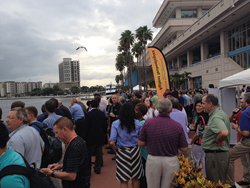
The Microwave Week Monday evening reception was preceded by the plenary session featuring Vida Ilderem, vice president and Intel Labs director, Integrated Computing Research, Intel Corp. Her lecture, “How Data, Devices and Personalization are Fueling Demand for Innovation” was a highlight of the night. She discussed how the Internet of Things (IoT) connects everything from appliances to cars and medical devices, stressing that industry and academia need to innovate faster to keep up with increasing expectations of users. With her company leading the effort, Ilderem also covered the required technology innovations for a digitized world where everything can be made intelligent and connected.
On Thursday afternoon the IMS closing ceremony featured “This Stuff is Fun!”, a fun and interactive talk by Quenton Bonds, research electronics engineer, NASA GSFC, and “No Excuses!” an inspiring personal journey by Kyle Maynard, athlete and N.Y. Times best-selling author. Bonds shared some of the challenges he faced as a youth and what motivated him to overcome these challenges while having fun along the way. Maynard’s keynote explained why there are no worthy excuses in life. Maynard was born with a condition known as congenital amputation that has left him with arms that end at the elbows and legs that end near his knees. He showed how everyone has the capacity to achieve their goals and why they should never give up.
Reviewing the IMS 2014 technical sessions, workshops and panels, much attention was paid to mmwave technologies, 5G, IoT, tunable filters/antennas, high efficiency amplifiers (envelope tracking, DPD, switched mode PAs, etc.) and biomedical devices/sensors. Envelope tracking has become so popular, nearly all the major test and measurement companies featured demonstrations on how to characterize and measure this technique.
The biggest news of the event was the significant company mergers and collaborations. The mergers of RFMD/TriQuint and Cobham/Aeroflex were announced just prior to IMS and Analog Devices (ADI) acquired Hittite, shortly afterward. These consolidations are making big waves in the industry. Collaborations included AWR/ANSYS with their interoperable design software; Agilent and Cascade’s plans to deliver probing test systems and Copper Mountain systems integration into several test systems such as Maury and Focus loadpull test sets. National Instruments’ RF presence is now a combination of companies such as AWR, Phase Matrix and NMDG, as well as their original test/measurement products and LABVIEW software.
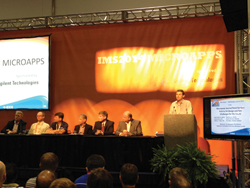
The MicroApps sessions offered many company executives the opportunity to discuss their new technologies and capabilities right on the exhibition floor. Microwave Journal coordinated a featured panel session for the MicroApps on the Challenges of 5G Technologies that included experts from both the test/measurement and semiconductor industries. Close to 110 people attended our session to learn more about this trending hot topic. EDI CON 2015 will dedicate an entire day of sessions on this topic in Beijing next April.
The IMS 2014 exhibition is approaching 600 participating companies, making it quite large and diverse. All types of RF/microwave companies ranging from material and device manufacturers to component and subsystem providers were represented. Microwave Journal highlighted close to 100 different products and services featured on the exhibition floor. A complete show review including videos and photos can be found at www.microwavejournal.com/IMS2014Exhibition.
The IEEE MTT-S Microwave Week was comprised of several conferences that were co-located at the Tampa Convention Center and other local venues. In addition to the IMS Conference, Microwave Week also hosted the IEEE RFIC and ARFTG conferences, and this year also hosted the WAMICON conference, an event that is typically held separately.
RFIC Symposium
The RFIC Symposium technical program showcased the latest innovations in RF integrated circuit design with sessions that covered a broad spectrum of topics. The conference included papers on RFIC design, system engineering, system simulation, design methodology, RF integrated circuits, fabrication, testing and packaging to support a wide range of RF applications.
RFIC added a number of new initiatives this year. Only the most innovative and highly-rated industrial papers were invited to present a poster (and optional demo) at a special Industry Showcase Session that was held concurrently with the evening RFIC reception on Sunday, June 1. Another new initiative for 2014 was aimed at increasing academic submissions through programs supporting students. The lead authors of the top three student papers received $500 honorariums along with special recognition at the RFIC Plenary Session award ceremony.
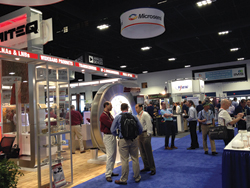
The RFIC workshops covered a wide array of topics. PA design workshops in particular, included: silicon and GaN PAs for RF and mm-wave applications, highly-efficient power amplifiers and smart transmitters, power amplifiers for software defined radios, and critical supporting circuit designs such as GaN-based power supply modulators.
In the frequency synthesis area, the “Frequency Synthesis for 60 GHz and Beyond: Architectures and Building Blocks” workshop focused on design techniques for low phase noise frequency synthesizers at mm-wave frequencies. Workshops on some of the emerging technologies in RF transceivers include techniques for handling interference and self-interference, RF and wideband data-converters for transmitters and receivers, and EMC/EMI-aware design practices for reducing coupling and interference in integrated circuits.
The RFIC Plenary Session held Sunday, June 1 began with some overall conference highlights, followed by the student paper awards. The first plenary speaker was Pieter Hooijman, vice president, R&D and strategy at NXP Semiconductors, with a paper entitled “How to Differentiate with RF Silicon Technologies in High Volume Applications?” The second speaker was Professor Lawrence Larson, dean of the School of Engineering at Brown University, who talked about “The Next Era of Wireless Communications – Enabling Revolutions in Health Care, Transportation, Energy and the Environment.”
Immediately following the Plenary Session, the new Industry Showcase Session and the RFIC reception were held in separate ballrooms. The inaugural RFIC Plenary Round Table Discussion was held next with leaders from the RFIC community engaging in a lively discussion on “Beyond 4G Wireless Communications: An RFIC Perspective.” During lunchtime on Monday, June 2 and Tuesday, June 3 the conference featured panel sessions on “Fabless Design: Got Any Problem with That?” and “Is Spectrum Explosion Muffled without Tunable RF?,” respectively.
83rd ARFTG Microwave Measurements Conference
Jon Martens, Conference Co-Chair
Capping off an exciting IMS 2014, the 83rd ARFTG Microwave Measurements Conference was held Friday, June 6 at the Tampa Marriott Waterside Hotel and Marina This year the conference was co-located with WAMICON 2014 to allow attendees to sample papers on a wide variety of topics and visit a greater assortment of vendor exhibits.
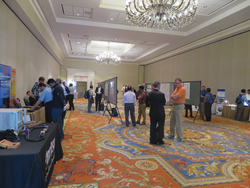
The theme of the ARFTG conference this year was “Microwave Measurements for Emerging Technologies’. Two invited papers helped motivate related discussions: “Instrumentation in Mixed-Signal and Mixed-Domain Emerging Technologies,” Nuno Borges Carvalho (University of Aveiro, Portugal) and “Microwave Measurements for Biological Materials Analysis,” Katia Grenier (LAAS-CNRS, France). Fourteen additional oral presentations on a variety of topics included AM/PM estimation, improved calibration approaches for loadpull, mm-wave S-parameter verification, calibrations for extreme impedances, active harmonic load-pull and source-pull measurements at X-Band, power amplifier output harmonic modeling and IQ mixer measurements. The interactive forum session consisted of 18 papers on a wide variety of measurement topics with ample time for discussions between authors and attendees. The conference attendees voted on the best oral and interactive forum papers with the winners to be announced at the next ARFTG Microwave Measurement Symposium to be held in Boulder, Colo., December 2-5, 2014.
Eighteen exhibitors presented their latest equipment, tools and components with considerable time for discussions with both ARFTG and WAMICON attendees throughout the day. Two ARFTG co-sponsored workshops entitled “Efficient RF Design using Practical Behavioral Models – Bridging the Gap between Measurement and Simulation” and “Challenges and Advances in Wafer-Level Calibration and Characterization at Millimeter and Sub-Millimeter-wave Frequencies,” were held earlier in the week. Co-sponsored IMS sessions relating to measurements and a nonlinear vector network analyzer (NVNA) users’ forum meeting were held on Thursday. In total, more than 100 attendees had the opportunity to absorb information on a plethora of measurement topics.
WAMICON Joins IMS 2014
Ray Pengelly, General Chair and Jing Wang, General Co-Chair
The 2014 IEEE Wireless and Microwave Technology Conference (WAMICON) was held in conjunction with IMS 2014, in a joint conference with the Automated RF Techniques Group (ARFTG). This special arrangement was chosen because WAMICON is a Florida-based regional conference, and most of its regular steering committee members were busy working on IMS.
The WAMICON portion of the week’s activities began Thursday afternoon during a session honoring the career and contributions of Dr. Rudy Henning, a long time professor at the University of South Florida. His academic career followed his professional career at Sperry, where he was chief engineer of the Sperry Microwave Electronics Division. At the conclusion of the session, the WAMICON-sponsored Rudolf E. Henning Award for Distinguished Mentoring was presented to Professor John Cressler of Georgia Tech. In his acceptance comments, Cressler described his personal views on mentorship and the methods he employs to support his graduate students as they progress through their studies and into their careers. Further comments were offered in a panel session, where Cressler was joined by the two most recent Henning Award recipients, John Volakis and Linda Katehi.
Later Thursday evening, a joint reception was held, celebrating the end of IMS and the beginning of the WAMICON and ARFTG conferences. During the reception, a group of graduate students participated in a special poster session, presenting updates on their research in various areas of microwave technology.
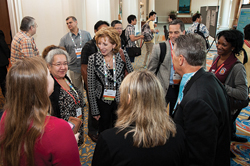
The plenary session on Friday morning, hosted by WAMICON General Chair Ray Pengelly, was a highlight of the event. The keynote speaker was Linda Katehi, Chancellor of the University of California, Davis. Her thought-provoking talk, “The Challenge to Diversify,” explained why gender equality in engineering made good business sense. The issue of gender bias has been discussed for decades, but the engineering profession remains more than 85 percent male. Katehi encouraged more women to seek careers in science and technology. Her common sense reason to hire female engineers – companies would create better products if more women were on the design teams.
The second plenary speaker, Upkar Dhaliwal of Future Wireless Technologies, offered many facts, figures and perspectives on the size and complexity of the wireless marketplace. Among the most important points made in his talk, “Future Wireless Communication Technologies 2020-30,” was the need to support rapid growth in wireless network traffic with higher density coverage through smaller cell size and flexible reconfigurability that responds to changes in demand. The “Internet of Things” continues to develop, with automated appliances, medical devices and environmental controls adding to the flow of data. As they reach large-scale implementation, support for these devices will require all types of communication technologies – short range wireless, ad hoc networks, commercial wireless, power line communications and cable or fiber wired networks.
The WAMICON program included eight sessions with oral presentations covering such topics as high efficiency power amplifiers, nano-electronics, medical and biological wireless systems, fabrication technologies, component design and antennas. Several invited papers offered unique insight into advanced research efforts in key areas of wireless and microwave technology. A large interactive poster session was held in the exhibits room and the adjacent foyer.
WAMICON had 140 participants, which is considered very good for a one-day conference that is part of a larger event. Thirty oral papers were scheduled, along with a sizable group of 51 poster papers. The poster session was expanded this year to accommodate quality papers that could not be included in the smaller number of oral paper sessions.
In 2015, WAMICON will once again be a stand-alone event, April 12-15 at the Hilton Oceanfront Hotel in Cocoa Beach, Fla. IMS 2015 will be held May 17-22 in Phoenix, Ariz. As the centerpiece of Microwave Week, IMS 2015 will continue to include RFIC and ARFTG conferences. Microwave Journal hopes to see everyone there next year.
